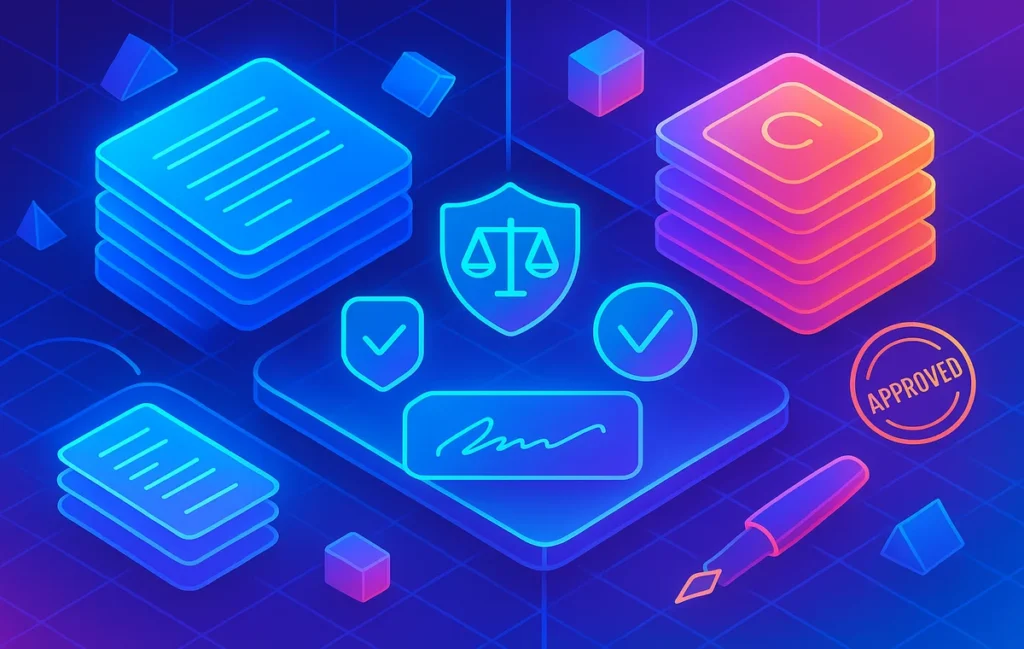🚀 Why eSignature Software Matters in 2025
The way organizations close deals, sign contracts, and validate agreements has changed forever. Paper-based signatures are no longer practical when teams are global, clients expect instant turnaround, and regulators demand secure compliance. This is where modern eSignature software steps in—offering legally binding signatures that scale from freelancers drafting a single NDA to enterprises running thousands of contracts per week.
For small businesses, eSignatures cut turnaround time by more than 70%, freeing founders from chasing signatures across emails. Enterprises, meanwhile, gain the ability to standardize templates, manage compliance under frameworks like eIDAS, ESIGN Act, and GDPR, and run audits at scale.
💡 Nerd Tip: Don’t think of eSignature tools as just a digital pen. They are workflow enablers that integrate with your CRMs, document automation systems, and billing apps.
If you’re already exploring Document Automation Software or evaluating Workflow Automation 101, adding eSignature software is the logical next step in your stack.
🛡️ Compliance First: Why Regulations Matter
One of the biggest misconceptions about eSignature tools is that “any digital scribble works.” In reality, compliance frameworks make the difference between an enforceable contract and a legal headache.
-
ESIGN Act (U.S.): Recognizes electronic signatures as valid and legally binding in the United States.
-
eIDAS (EU): Sets the standard for electronic identification and trust services across Europe, distinguishing between simple, advanced, and qualified electronic signatures.
-
GDPR (EU): Ensures that personal data collected during signature workflows is stored, processed, and deleted with consent and transparency.
A 2024 Gartner survey revealed that 61% of enterprises consider “compliance verification” their number one buying factor for eSignature platforms. If you’re dealing with cross-border clients, this isn’t optional—it’s survival.
💡 Nerd Tip: Always ask vendors about audit trails, encryption, and storage jurisdiction. A low-priced plan without compliance may cost you ten times more in legal exposure later.
When you compare platforms like DocuSign, HelloSign, or PandaDoc, compliance often explains the pricing gaps. This is where enterprise buyers differ sharply from solopreneurs.
📑 Templates: Contracts, NDAs, and Proposals at Scale
Templates are the backbone of eSignature productivity. They let you standardize frequently used documents—think employment contracts, sales proposals, or vendor NDAs—without reinventing the wheel every time.
A founder closing ten deals a month doesn’t have time to manually rebuild a contract in Word. With platforms like PandaDoc or Adobe Sign, you can create a template once, embed smart fields, and send it in under two minutes. This doesn’t just save time—it ensures brand consistency, legal accuracy, and a polished client experience.
On the enterprise side, teams often maintain hundreds of active templates. Here, the ability to control access, enforce legal language, and integrate templates directly with CRM or ERP systems is critical. In fact, a mid-market SaaS company shared on X earlier this year:
“Switching to template-driven NDAs in PandaDoc cut our sales cycle by 5 days on average. That’s literally a week of revenue unlocked every month.”
💡 Nerd Tip: Templates aren’t just about speed—they’re about reducing risk. Standardized contracts make sure no employee “accidentally” deletes a liability clause.
If you’ve already read our deep dive on Best Workflow Automation Tools for Solopreneurs, think of templates as the automation layer for legal documents.
💰 Pricing Tiers: SMB vs Enterprise
Pricing in eSignature software often reflects how deeply you need compliance and template sophistication. For small businesses, most platforms start with $10–$30 per user per month, covering unlimited documents and basic templates. For enterprises, costs can jump to $40–$100 per user per month, especially when advanced compliance, API integrations, and dedicated onboarding come into play.
Take DocuSign as an example: their entry plan works fine for freelancers, but once you add advanced compliance (eIDAS) and integrations with Salesforce, pricing scales quickly. Compare that to HelloSign, which remains SMB-friendly but less feature-rich for enterprises.
💡 Nerd Tip: Don’t just compare sticker prices. Evaluate “price per closed deal.” If an extra $20 per user unlocks compliance across Europe, the ROI is obvious.
This pricing dynamic mirrors what we’ve seen in Zapier vs. Power Automate vs. IFTTT—tools may look similar at first glance, but scale and compliance dictate the true cost of ownership.
🔍 Tool-by-Tool Breakdown
Below is a structured look at the five leading eSignature tools in 2025.
| Tool | Compliance (eIDAS/ESIGN/GDPR) | Templates | Pricing (per user/mo) | Best For |
|---|---|---|---|---|
| DocuSign | Full global compliance, advanced audit trails | Extensive, CRM-ready | $25–$90 | Enterprises & cross-border deals |
| HelloSign (Dropbox Sign) | ESIGN & GDPR, limited EU | Basic templates | $15–$40 | SMBs & freelancers |
| PandaDoc | ESIGN, GDPR, strong audit trail | Advanced, sales-driven | $19–$79 | Sales teams & growing startups |
| Adobe Sign | Full global compliance, part of Adobe Cloud | Extensive legal/HR templates | $25–$95 | Enterprises already in Adobe ecosystem |
| SignNow | ESIGN, GDPR, affordable compliance | Decent template support | $8–$30 | Budget-conscious SMBs |
💡 Nerd Tip: If you’re running a bootstrapped startup, SignNow may cover 80% of your needs at 30% of the cost.
⚡ Ready to Build Smarter Contracts?
Start with tools like DocuSign or PandaDoc to ensure your deals are signed faster, safer, and smarter. Unlock compliance and template power without legal headaches.
🔌 Integration Ecosystem: More Than Just a Signature
Choosing an eSignature platform isn’t only about where your contracts are signed—it’s about how deeply those signatures connect to the rest of your workflow. In practice, integrations often determine whether your sales, HR, or legal team can operate at full speed.
DocuSign is the gold standard for enterprise integrations, especially with Salesforce and Microsoft Dynamics, giving global sales teams real-time updates as contracts move across the funnel. PandaDoc, meanwhile, has become the favorite of startups and mid-sized businesses because of its tight HubSpot and Pipedrive integrations—perfect for founders who want their proposals auto-synced with CRM pipelines. HelloSign, rebranded as Dropbox Sign, leans on its ecosystem by integrating smoothly with Dropbox and Google Drive, keeping workflows light and cost-effective for freelancers.
💡 Nerd Tip: Don’t treat your eSignature tool as a standalone app. It should be the handshake between your CRM, billing platform, and document automation system. If you’ve been exploring Workflow Automation 101 or diving into Top 10 Automation Tools for Marketers, make sure your chosen signature tool plugs in just as seamlessly.
🔒 Security & Authentication Layers
Compliance ensures legality, but security ensures trust. Not all eSignature software handles authentication equally, and that difference can be decisive when sensitive contracts are on the line.
Most SMB-friendly tools rely on email verification or SMS one-time passwords to validate signers. This works for standard agreements like NDAs or sales contracts. But once you enter high-stakes territories—like financial services or cross-border employment contracts—advanced measures come into play. Platforms such as DocuSign and Adobe Sign offer multi-factor authentication, government ID verification, and even biometric confirmation in some regions.
A 2024 Forrester study found that 72% of enterprise buyers rated multi-factor authentication as “critical” for adoption. For freelancers, these layers may feel excessive, but for regulated industries they are non-negotiable.
💡 Nerd Tip: Always map your authentication level to the risk profile of your deals. For a $500 design project, email verification may be fine. For a $5M cross-border merger, you’ll need a digital fortress.
📚 Case Studies: Real-World Wins
The theory of faster contracts is persuasive, but nothing drives the point home like real-world examples. Consider these quick snapshots:
A SaaS startup in Berlin adopted PandaDoc to streamline sales proposals. Before switching, their average deal cycle dragged on for 12 days after verbal agreement. After standardizing templates and using eSignatures, that lag shrank to 7 days. As their COO shared on X:
“Five days faster doesn’t sound huge until you multiply it across 40 deals a quarter. That’s millions hitting the books sooner.”
Meanwhile, a U.S.-based law firm handling international arbitration leaned on DocuSign’s advanced compliance. In one case, opposing counsel challenged the validity of an electronically signed agreement. The built-in audit trail, timestamps, and encrypted storage passed scrutiny in court, saving the client weeks of delays and thousands in legal fees.
💡 Nerd Tip: When evaluating tools, don’t just read vendor feature lists. Hunt for user stories in your own industry. They often reveal hidden benefits—or red flags—that marketing pages never mention.
🔮 The Future of eSignature: AI & Blockchain
The future of eSignature won’t just be faster—it will be smarter and more tamper-proof. Artificial Intelligence is already reshaping how contracts are written. Imagine uploading a rough draft NDA, and the platform automatically highlighting missing clauses, suggesting standardized terms, or flagging risks. PandaDoc is experimenting with AI-driven “clause suggestions,” while startups like Juro are using natural language models to predict which edits a client is most likely to accept.
At the same time, blockchain-backed audit trails are gaining traction. Instead of storing signature events in a vendor’s private cloud, transactions are logged immutably on a distributed ledger. This makes fraud almost impossible and creates a transparent proof chain that regulators and courts can trust without question.
💡 Nerd Tip: Even if you don’t need blockchain-level security today, choose vendors that are experimenting with it. The future-proofing may save you from a forced migration later.
📊 Hidden Costs & ROI Calculations
Pricing pages tell only half the story. What really matters is the return on investment—the financial impact of faster signatures and reduced legal risk.
Take this example: a 10-person sales team closes an average of 15 deals each per month, with each deal worth $5,000. That’s 150 deals monthly, totaling $750,000 in pipeline revenue. If eSignature tools reduce the average contract lag by 3 days, cash enters the business almost a week earlier. Faster cycles improve cash flow, reduce financing needs, and can even boost customer satisfaction.
Now consider the flip side: a “cheap” eSignature solution without proper compliance could invalidate just one major $100,000 deal. That lost revenue dwarfs years of subscription fees.
💡 Nerd Tip: Don’t evaluate cost per seat—calculate cost per closed deal. In most cases, the right eSignature tool pays for itself after a single contract.
📬 Want More Smart Workflow Insights?
Subscribe to our free newsletter and get weekly tips on automation, productivity, and AI-powered tools—straight from the NerdChips lab.
🔐 100% privacy. No spam. Just high-quality insights for builders and creators.
🧠 Nerd Verdict
eSignature software is no longer a “nice-to-have.” In 2025, it is a foundational layer of any digital workflow—whether you’re a freelancer sending your first NDA or a multinational enterprise closing billion-dollar contracts.
-
For SMBs: HelloSign or SignNow keep costs down without sacrificing legality.
-
For scaling startups: PandaDoc balances template automation with CRM integration.
-
For enterprises: DocuSign and Adobe Sign remain unmatched in global compliance and audit capabilities.
The decision ultimately comes down to risk tolerance and deal velocity. Pay less and you risk non-compliance in key regions. Pay more, and you gain peace of mind, speed, and brand consistency.
❓ Nerds Ask, We Answer
💬 Would You Bite?
If you had to choose between saving money with a budget-friendly eSignature tool or paying more for bulletproof compliance, where would you place your bet?
Crafted by NerdChips for creators and teams who want to sign smarter and scale faster.



